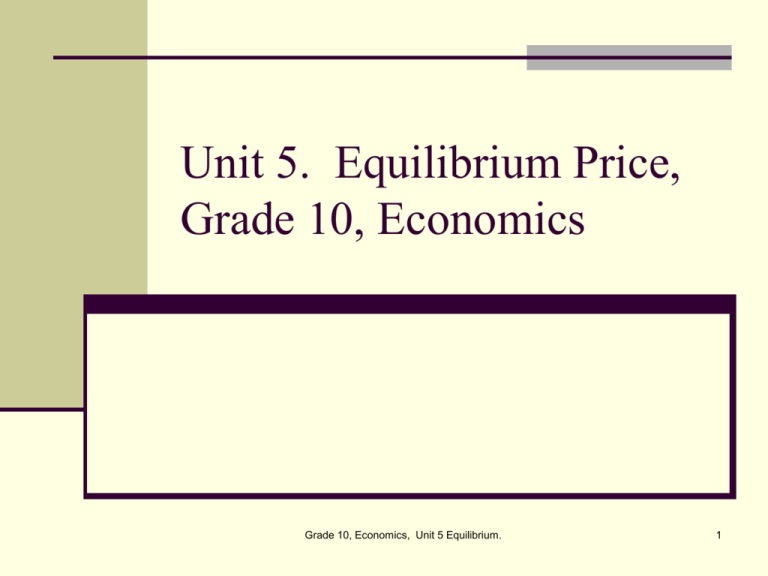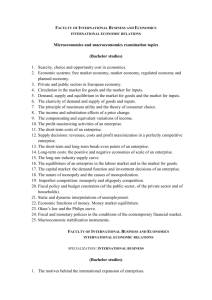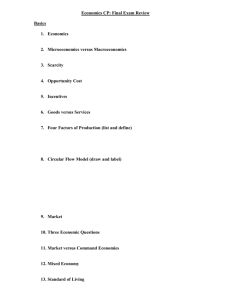Unit 5. Equilibrium Prices
advertisement

Unit 5. Equilibrium Price, Grade 10, Economics Grade 10, Economics, Unit 5 Equilibrium. 1 Demand: Effective demand, The willingness and ability to buy a product. Demand and price are inversely related. - Demand will rise as price falls. - Demand will fall as price increases. Grade 10, Economics, Unit 5 Equilibrium. 2 Individual and Market Demand: Study individual. Study market. Individual demand: The amount of product an individual would be willing and able to buy, at different prices. Market demand: The total demand for a product at different prices. It is found by adding up each individual’s demand at different prices. Grade 10, Economics, Unit 5 Equilibrium. 3 A Demand Schedule: Lists the different quantities demanded of a product, at different prices over a particular time period. Grade 10, Economics, Unit 5 Equilibrium. 4 A Demand Schedule: Daily Demand for Train Tickets from Oxford to London in The Winter Months. (Fig 1.) Price (Pound sterling) Quantity demanded 50 2200 45 2500 40 3000 35 3800 30 5000 25 7000 Grade 10, Economics, Unit 5 Equilibrium. 5 Activity 1. Using the following demand schedule, plot the demand curve for rooms in a hotel in Delhi. Price (Rupees) 800 700 600 500 400 300 Number of rooms 10 20 35 55 80 110 Grade 10, Economics, Unit 5 Equilibrium. 6 The Effect of a Change in Price on Demand. Fig 4. Fig 5. An extension in demand: A rise in the quantity demanded caused by a fall in the price of the product itself. A contraction in demand: A fall in the quantity demanded caused by a rise in the price of the product itself. Grade 10, Economics, Unit 5 Equilibrium. 7 Supply: The willingness and ability to sell a product. A rise in price will lead to a rise in supply. A decrease in price will lead to a decrease in supply. Grade 10, Economics, Unit 5 Equilibrium. 8 Individual and Market Supply Individual supply: The supply of one plant/firm. Market supply: The total supply of a product produced by all the firms in the industry. Grade 10, Economics, Unit 5 Equilibrium. 9 A Supply Schedule: Daily Supply of Train Tickets from Oxford to London in Winter Months Price (Pound sterling) Quantity supplied 50 6000 45 5000 40 4300 35 3800 30 3600 25 3500 Grade 10, Economics, Unit 5 Equilibrium. 10 Supply Fig 6. Fig 7. Grade 10, Economics, Unit 5 Equilibrium. 11 Price Determination: Equilibrium price: - The price where demand and supply are equal. - Market clearing price. Grade 10, Economics, Unit 5 Equilibrium. 12 The Daily Demand for and Supply of Train Tickets from Oxford to London in Winter Months. Price Quantity supplied 50 Quantity demanded 2200 45 2500 5000 40 3000 4300 35 3800 3800 30 5000 3600 25 7000 3500 Grade 10, Economics, Unit 5 Equilibrium. 6000 13 Equilibrium: Fig 8. Fig 9. Fig 10. Fig 11. Grade 10, Economics, Unit 5 Equilibrium. 14 Activity: As the 2006 World Cup approached, sales of Brazilian football shirts increased not only in Brazil but also in a number of other countries. Two weeks before the compensation started, shops in London and Sao Paulo reported that demand for shirts was outstripping supply. a. On a demand and supply diagram, illustrate the market for Brazilian football shirts in Sao Paulo two weeks before the 2006 World Cup. b. What would you have expected to happen to the price of Brazilian football shirts in Sao Paulo in this situation? Explain your answer. Grade 10, Economics, Unit 5 Equilibrium. 15






![[I-324] Topical Seminar on International Trade](http://s3.studylib.net/store/data/008957979_1-f57606cd75cb7b10de030dcd936eae4f-300x300.png)

